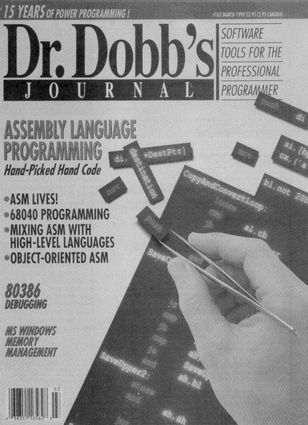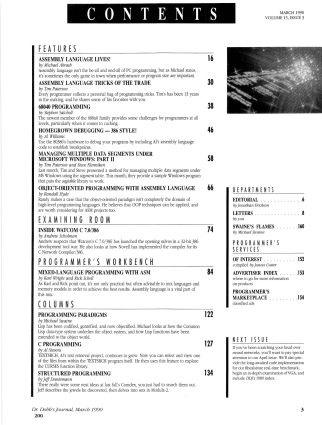
[author : Jonathan Erickson] #Edito
TABLE OF CONTENTS
[author : Michael Abrash]
Assembly language isn’t the be-all and end-all of PC programming, but as Michael states, it’s sometimes the only game in town when performance or program size are important.
[author : Tim Paterson]
Every programmer collects a personal bag of programming tricks. Tim’s has been 13 years in the making, and he shares some of his favorites with you.
[author : Stephen Satchell]
The newest member of the 680x0 family provides some challenges for programmers at all levels, particularly when it comes to caching.
[author : Al Williams]
Use the 80386’s hardware to debug your programs by including Al’s assembly language code to establish breakpoints.
[author : Tim Paterson and Steve Flenniken]
Last month, Tim and Steve presented a method for managing multiple data segments under MS Windows using the segment table. This month, they provide a sample Windows program that puts the segtable library to work.
[author : Randall Hyde]
Randy makes a case that the object-oriented paradigm isn’t completely the domain of high-level programming languages. He believes that OOP techniques can be applied, and are worth considering for ASM projects too.
[author : Andrew Schulman ]
Andrew suspects that Watcom’s C 7.0/386 has launched the opening salvos in a 32-bit 386 development tool war. He also looks at how Novell has implemented the compiler for its C Network Compiler/386.
[author : Karl Wright and Rick Schell]
As Karl and Rick point out, it’s not only practical but often advisable to mix languages and memory models in order to achieve the best results. Assembly language is a vital part of this mix.
[author : Michael Swaine]
Lisp has been codified, gentrified, and now objectified. Michael looks at how the Common Lisp data-type system underlies the object system, and how Lisp functions have been extended to the object world.
[author : Al Stevens]
TEXTSRCH, Al’s text retrieval project, continues to grow. Now you can select and view one of the files from within the TEXTSRCH program itself. He then uses this feature to explore the CURSES function library.
[author : Jeff Duntemann]
There really were some neat ideas at last fall’s Comdex, you just had to search them out. Jeff describes the jewels he discovered, then delves into sets in Modula-2.
[author : you]
[author : Michael Swaine]
[author : compiled by Janna Custer]
where to go for more information on products
classified ads
